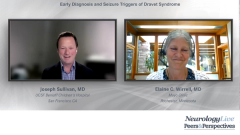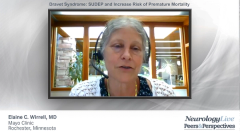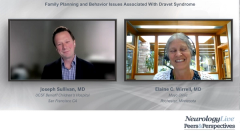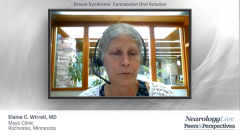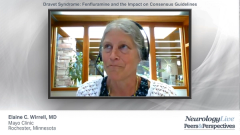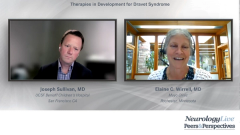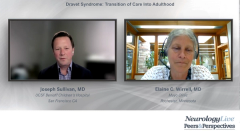
Dravet Syndrome: SUDEP and Increase Risk of Premature Mortality
Elaine C. Wirrell, MD, explains the increased risk of sudden unexpected death in epilepsy (SUDEP) in patients with Dravet syndrome and how to talk about it with caregivers and families.
Episodes in this series

Joseph Sullivan, MD: One particularly sensitive topic to talk about is SUDEP [sudden unexpected death in epilepsy]. I’m curious, how do you talk about them? It’s certainly something that we’re talking about with all our patients but at different time points. Specifically, in Dravet syndrome, how do you approach that.
Elaine C. Wirrell, MD: It’s really important that families understand the increased risk and, as you say, hear it from us because we can help put it into context. For most families, when they see their child having a prolonged seizure, it’s not a stretch to say that they often wonder if that’s something that’s actually going to kill their child. For many families, if you’ve seen your child have that prolonged, especially convulsive seizure, a hemiconvulsive seizure, that’s already at the top of your mind. You’re worried, “Could this actually kill my child?”
That’s a reasonable segue to bring that up. For Dravet syndrome, the risk of SUDEP is very high, so if we follow on average a 100 children or a 100 persons with Dravet syndrome for a year, 1 of those people is going to die of SUDEP, and that’s much higher than in most other epilepsy types. When I’m discussing that with my family, I would say, do you worry about harms that seizures can do? They’ll typically nod their head. [I ask] what sorts of things, and do you ever worry that a seizure might kill them? They say yes, right? It’s clearly something they’ve thought about. You’re not bringing up something new. You’re addressing something that they’ve been thinking about in the vast majority of cases. I let people know that yes, that’s a risk, and you can’t prevent it. But the best thing we can do to reduce it would be to reduce seizure burden, to get better seizure control, and here’s why we want to work together and partner together to get the best seizure control we can.
Joseph Sullivan, MD: Absolutely. When you look at the literature that has concluded this SUDEP risk, they also look at the different causes of SUDEP. It can be the very young. It can be this acute encephalopathy. But pervasive along all that are seizures, so I certainly know that when I’m having that discussion with my families, [we discuss] the importance of trying to get the best control of seizures that we can and not falling into this complacency of, well, things were better than they were. But equally important is to have an aggressive rescue plan, right? Early diagnosis, being able to say that your child is going to be at risk for these prolonged seizures, and anything that we can do to prevent. Even if we can’t reduce overall seizures, if we can stop long seizures—I don’t think we have data necessarily to support what I’m going to say—I have to think the SUDEP risk will be lower if we can shorten these prolonged seizures.
Elaine C. Wirrell, MD: Certainly. The acute encephalopathy, right? Which the young children can develop. Those typically happen associated with febrile status.
Joseph Sullivan, MD: Yes.
Elaine C. Wirrell, MD: If we can reduce the duration of that seizure and turn it into a 2-minute seizure as opposed to a 45-minute seizure.
Joseph Sullivan, MD: Exactly.
Elaine C. Wirrell, MD: Yes.
Joseph Sullivan, MD: Thankfully, in the last year, a lot of new options have become available in terms of some of the nasal forms of rescue medications. Of course, there’s still diazepam and [other benzodiazepines]. I don’t necessarily claim to understand the physiology behind why 1 benzodiazepine works for 1 patient and doesn’t work for another, but certainly those are our main go-to drugs as rescue medicines. I know that in my practice, all my patients with Dravet have a seizure rescue plan that’s a little more detailed than maybe a patient with epilepsy. It even comes as a care coordination note in the electronic medical record that if they hit our ER [emergency department], this is what works for them. It’s important to have this individualized approach, because we learn unfortunately that some of these patients come in within a prolonged seizure. You go through the normal algorithm that ER physicians are taught, and it doesn’t work for that patient, but something else does. I certainly think it’s important having that individualized treatment plan. I’m not sure if you do the same at your practice.
Elaine C. Wirrell, MD: Yes, I fully agree. If you look at 10 kids with Dravet, they have probably 8 to 10 different rescue plans.
Joseph Sullivan, MD: Yes, exactly. That’s important for families to hear, that you may read something or hear something—whether it’s connecting through the Dravet Syndrome Foundation or a Facebook page—that another person the same age as your child has Dravet and has this rescue plan. That doesn’t mean that 1 is better than the other, or 1 is wrong, or 1 is right. Each person comes to their own plan, usually based on what has worked for them.
Thank you for watching this Neurology Live® Peers & Perspectives®. If you enjoyed the content, please subscribe to our e-newsletters to receive upcoming programs and other great content in your in-box. Thank you so much.
Transcript Edited for Clarity
Newsletter
Keep your finger on the pulse of neurology—subscribe to NeurologyLive for expert interviews, new data, and breakthrough treatment updates.

